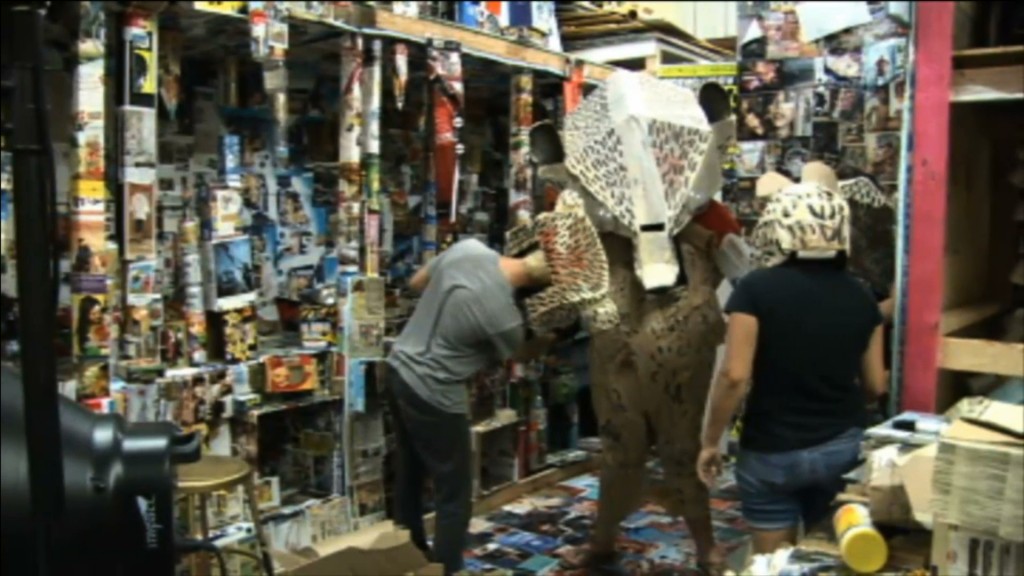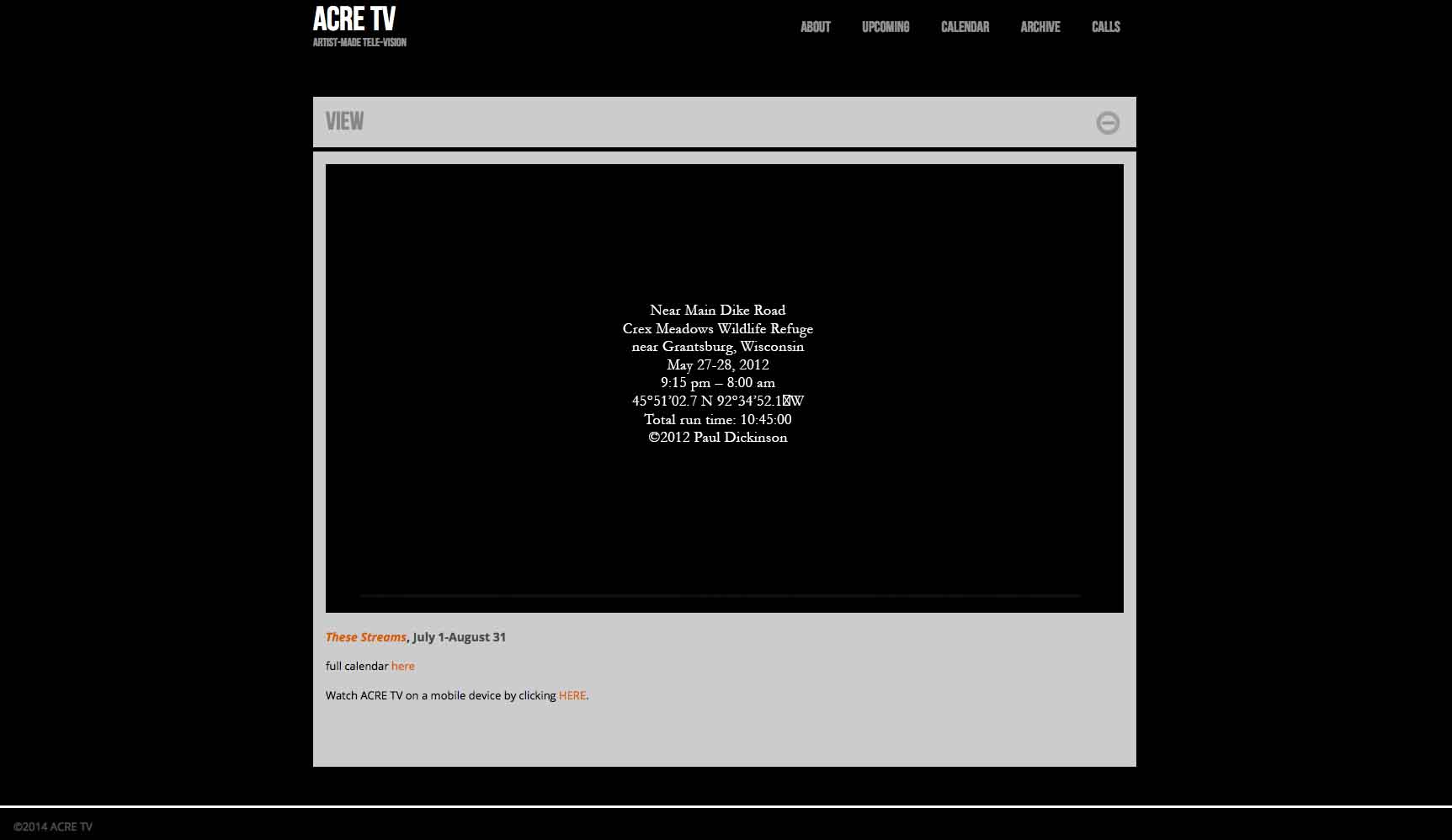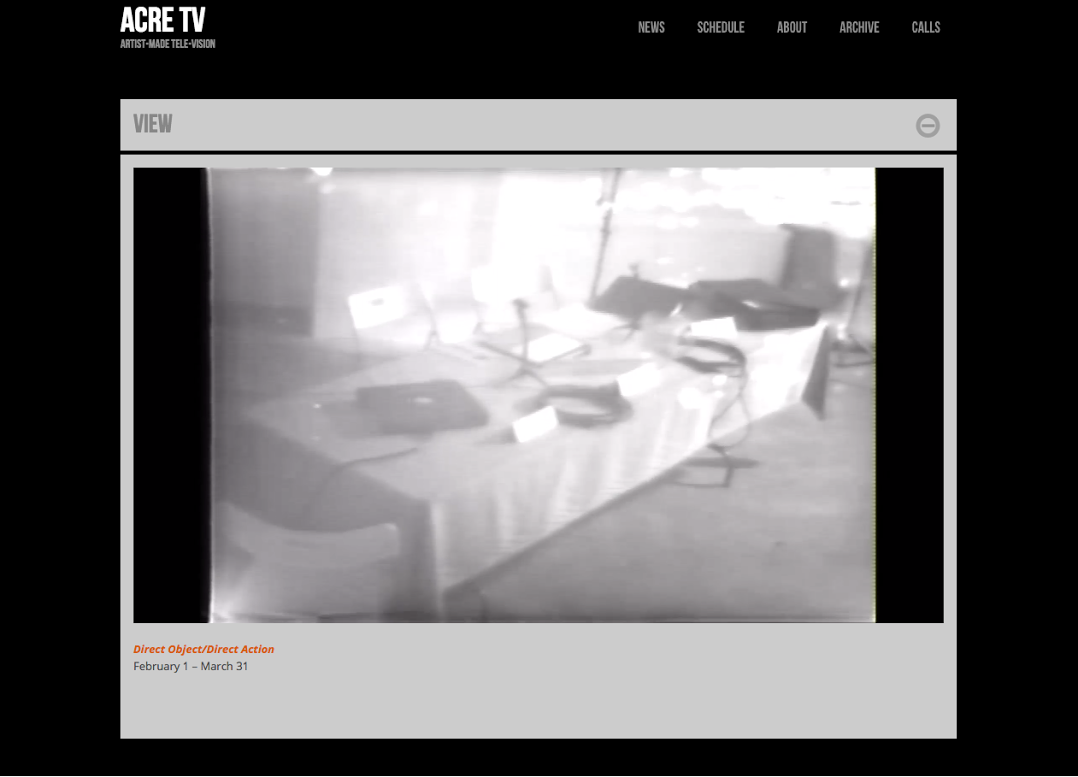One of the benefits of running a business with a life-long friend is that, together, we can decide to take on passion projects that strike our curiosity and grow our skill set even if they don’t immediately show a profit. Over the last year and a half much of that “passion project” time has gone into building and running ACRE TV, a 24/7 artist-made livestreaming tele-vision network.
In this post I’m going to attempt to describe ACRE TV for the uninitiated, and lay out some of the components and challenges one might meet when building a 24/7 streaming network. I’ll detail the types of forms we’ve been interested in programming on ACRE TV, and give some specific examples of programs that worked especially well. Finally, I’ll list and briefly describe some of the other artist-made streaming projects we’ve become watchers and fans of in the last two years.
ACRE TV: Artist-Made Tele-Vision
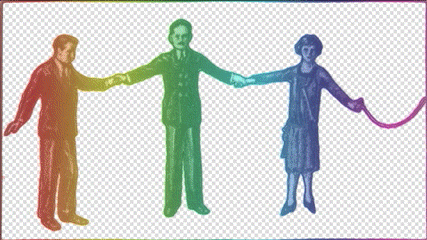
ACRE TV’s logo is adapted from an image found in Jeffery Sconce’s “Haunted Media”. This book details the interesting history of broadcast, and it’s relationship to Spiritualist movements– people who heard and saw the supernatural in the broadcast signal.
The Concept
ACRE TV officially launched on February 15, 2014, but the conceptualizing and planning started more than a year earlier. Back in 2013, Nick and I had the curious challenge of creating a reel to showcase the work we had done, but found that the typical 2-3 minute video form didn’t do justice to our live stream productions. As has been pointed out in studies (see page 11), people watch live streaming video online longer than video-on-demand, at a ratio of almost thirteen to 1. Condensing our multi-hour live stream productions into an edited, short video-on-demand seemed to totally ignore the central appeal of live streaming. Quickly, we wondered what a 24/7 network of our work would look like, where a viewer would be able to see our work in full duration, consciously programmed in a playlist that made sense. Basically, we wondered about creating our very own TV network.
Simultaneously, we were having conversations with two others future ACRE TV co-directors: Kera MacKenzie, and Nicholas Wylie.
Kera and I share a collaborative art practice and had been dreaming of creating an uninterrupted live streaming video signal that evolves over a long period of time (think months). This vision of a signal was partially inspired by driving late night through the Southwest U.S. together, listening to strange AM stations slowly re/dissolve in and out of the static, as our radio’s antenna drifted through their broadcast range. The feeling of these small, strange signals that continue on unabated — even when you aren’t around to hear them — is something that still gives me goose bumps.
Nick Wylie is a friend, collaborator, and also co-founder of ACRE Residency, a vital, volunteer-run organization in the Chicago and US emerging artist scene that has hosted a summer long residency in Southwest Wisconsin for the past five years. ACRE also organizes hundreds of art shows in Chicago and elsewhere every year. Hearing our dream to create a DIY network, Nick W. immediately offered the reputation and network of artists that he and his ACRE collaborators have painstakingly developed.
So, exactly one year ago yesterday, ACRE TV launched with our first program, PLEASE STAND BY.
The Technology
Creating a broadcast network from scratch is technically difficult. After more than three years of focusing on live stream productions, Nick and I had developed a certain expertise in running video streams that lasted up to eight hours, but building a DIY network was a new challenge, requiring an infrastructure capable of indefinite streaming as well as the ability to switch to specific programming at specific times. Initially, we tried using familiar tools, and finally, brought a couple of new ones into our repertoire.
Attempt 1 (The Wirecast Method):
For Please Stand By, we streamed test patterns created by 25 amazing film and video artists. Using a non-linear editing system, we exported these videos into a single ~1.5 hour file and used Wirecast to stream it, looping, to one of our go-to content delivery networks, DaCast. Nick described this method in some detail at the blog on our old company website. This Wirecast method was OK– we were able to get streaming video to our website!– but it had some serious flaws. First, besides the very rudimentary apple script that Nick mentions in the above link, we weren’t able to schedule anything to switch at specific times of the day. Second, because Wirecast isn’t made to run day-long streams, the network was going down almost every other day, leaving us the stressful job of babysitting the stream to restart it when it failed, day and night. Third, this method tied up a computer (generously lent by ACRE) for the entire run of the show.
Attempt 2 (The Wowza Method):
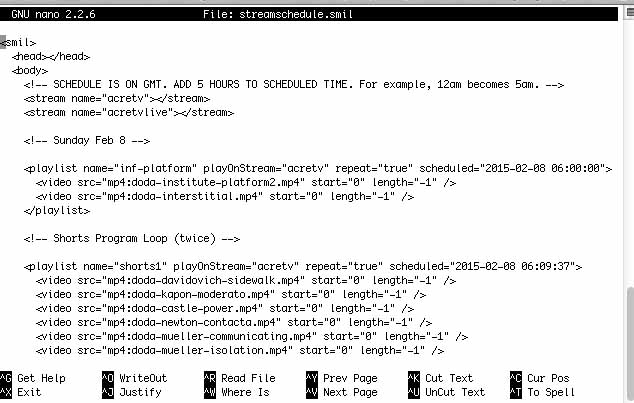
A portion of a stream schedule for Direct Object/Direct Action.
Knowing that the “Wirecast Method” wasn’t sustainable, Nick started looking into the software behind other streaming networks. The solution he came upon is Wowza, server-side streaming video software. Wowza is used by hundreds of businesses and organizations and is the software behind innovative streaming projects like ChatRoulette and Twitch.tv. It has become the backbone for ACRE TV.
To install Wowza we signed up for the free six-month license and rented an Amazon AWS instance. Nick performed some Ubuntu magic to set up the software, and suddenly we had our very own streaming video server. Hopefully Nick will cover Wowza in more detail in a future post, but at a fundamental level Wowza allowed us to create a text-based scheduler that will switch, at specific times, between videos we have uploaded to our server and live events that any of our artists can stream to our very own RTMP address. Also, because Wowza runs directly on the streaming server, it streams perfectly without (almost) ever going down and frees up the ACRE-lent computer.
Additionally, we purchased a license for JW Player that would take the stream and play it back on our website, and the Wowza transcoder that will create multiple bit-rate streaming files automatically to provide a better user-end experience of the stream. By the time we launched our second thematic show, These Streams, we were running ACRE TV off of Wowza.
The Organization and the Artwork
To create a 24/7 artist-made tele-vision network we needed to program many hours of art tele-vision. We, the four co-directors, quickly realized the enormity of the task and gathered a heady group of artists and curators* whose interests somehow overlap with tele-vision. As a group, we decided to structure ACRE TV into two-month programs, each based on a specific theme, while making room for independently themed programming to run throughout the year(s). We also talked at length about the type of work we were hoping to show on ACRE TV that would distinguish it from other traditional film and video festivals or programs. In the end, there are five forms of film/video/performance that we are especially interested in showing. I’ll describe each below and give an example from some of our favorite work that has played, or is currently being played, on ACRE TV.
*ACRE TV is completely volunteer-run. Our operational costs are paid for with generous financial support from the Propeller Fund, ACRE, as well as donations from viewers. You can donate to ACRE TV here.
Canned:
Canned — meaning, having already been finished — video is the source of all video-on-demand and also has a place on a live stream network. We stream canned video on ACRE TV from some of the most interesting contemporary experimental film/video makers (Jodie Mack, Ben Russell, Cauleen Smith, Peter Burr, John Kilduff and on and on) and when we do we try to be very considerate of how the schedule can support it. A good example of time-specific canned video happened in our third show, Psychedelicatessen, in which we programmed work to be shown during specific mealtimes. For instance, Jodie Mack’s “The Future Is Bright“, a gentle piece of devotional cinema, led off our DINNER program like saying,”grace”.
- Our poster for Psychedelicatessen, a two-month stream melding FOOD and MIND.
Live:
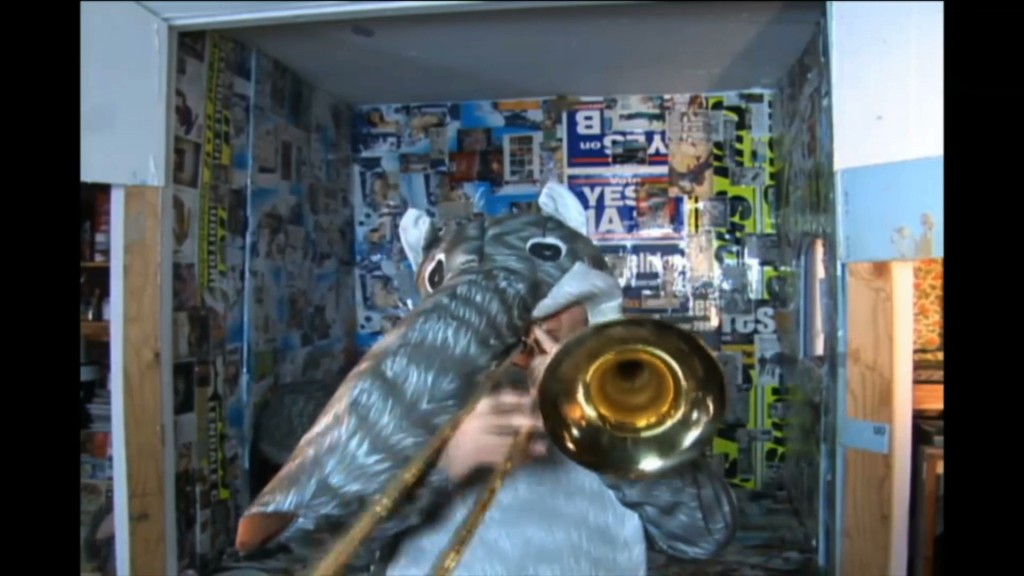
Stills from Joseph Herring’s Runnel: Episode 1 (30 Min)
Live video is central in our work as Mainstream, as well as on ACRE TV. In one year on ACRE TV we’ve broadcast more than 100 hours of live programming by 10+ artists. One proud example is Joseph Herring‘s RUNNEL, in which the Pensacola FL artist live streamed from his studio at the University of West Florida with a group of student collaborators. RUNNEL is a sci-fi contemplation on contemporary art practice through the lens of LARPed small tailed weasels.
The livestream form, so positioned for peeks down rabbit-holes, nicely delivered viewers a documentary peephole into the animal world of cultural production. The simultaneous chaos of the sets/costumes and mundanity of the activities (sleeping, grooming, limbo) took advantage of two contrasting connotations of livestream: precariousness and boredom.
Episodic:
Episodic programs work as well on ACRE TV as they do on traditional broadcast networks. In that vein, it’s been it’s been an honor to show “Made Up with Danny Volk“, a generous, accessible art-talk show program hosted by the charming Danny Volk, who interviews, and is made-up by, working contemporary artists in their studios. Appointment tele-vision makes an event out of a new piece.
Durational:
It quickly becomes apparent that the central subject of the live stream is time, and so it’s no surprise that the fourth category of work we’ve found to be most effective is a fourth descriptive for a kind of time. Durational pieces, ones that stretch over long periods, are at home on a live stream because of the relative durability and inexpensive of the live stream form as compared to most film/video exhibition formats. One of the pleasures of durational works is how it uniquely relates to a human body’s sense of chronology. Where a two-minute video can be remembered as almost happening outside of time — like an object, albeit one with a plot or characters or tone — a durational work happens as you happen.
Paul Dickinson, a sound artist who lives in Chicago, created a series of 11 hour audio recordings made in remote areas throughout the upper midwest. For two months on ACRE TV during These Streams, you could go to sleep listening to vibrant recordings of crashing thunderstorms in Northwest Wisconsin and wake up to hear the same rain delicately falling off the trees and know that your body had gone through something equivalent.
Experimental Broadcasts:
Experimental can be a catch-all, but in this case I am referring to work that uses the form to try out something new. James N Kienitz Wilkins contacted ACRE TV about the possibility of airing Public Hearing in Progress, a series of 14 eight-hour vhs tape recordings from a security camera, made during the rehearsals and production of his feature length film Public Hearing. The original 16mm film involves the re-performance of a rural American town debating whether to replace a Wal-Mart with a super Wal-Mart. Watching segments of the 100+ hour project you quickly become aware of tedium and collaboration it takes to make a film or a democracy.
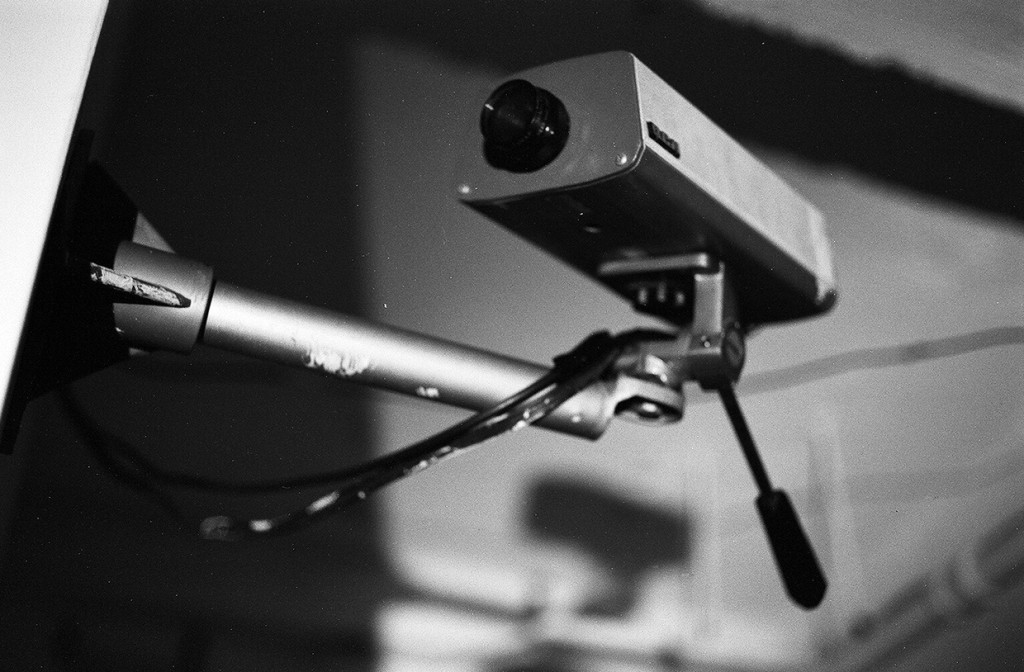
Still from Public Hearing by James N. Kienitz Wilkins
To learn more about PHIP, you can read an interview with James via Bomb Magazine, and you can watch Public Hearing, hosted in conjunction with the airing of PHIP, on James’ website.
How to Watch, or Make, ACRE TV
Watch ACRE TV at www.acretv.org
Consult ACRE TV’s schedule here.
You can see our archive, including information on every program played on ACRE TV here.
We post all of our open calls here, and you can apply to make independently themed work here.
We are always looking for tech savvy creative types to help us build on the back-end of ACRE TV. If you know programming and would like to help us build an interface to make stream scheduling more intuitive, contact us here with ACRE TV TECH HELP as the subject.
Other Artist-Made Broadcast Projects That We Like
As much as we like to tell ourselves we are on to something new, it’s satisfying to know that there are lots of contemporary online broadcast artist projects that are doing the good work. Below are some of the ones we’ve discovered. Please check these, and the amazing historical artist broadcast projects that have come before ACRE TV, out:


